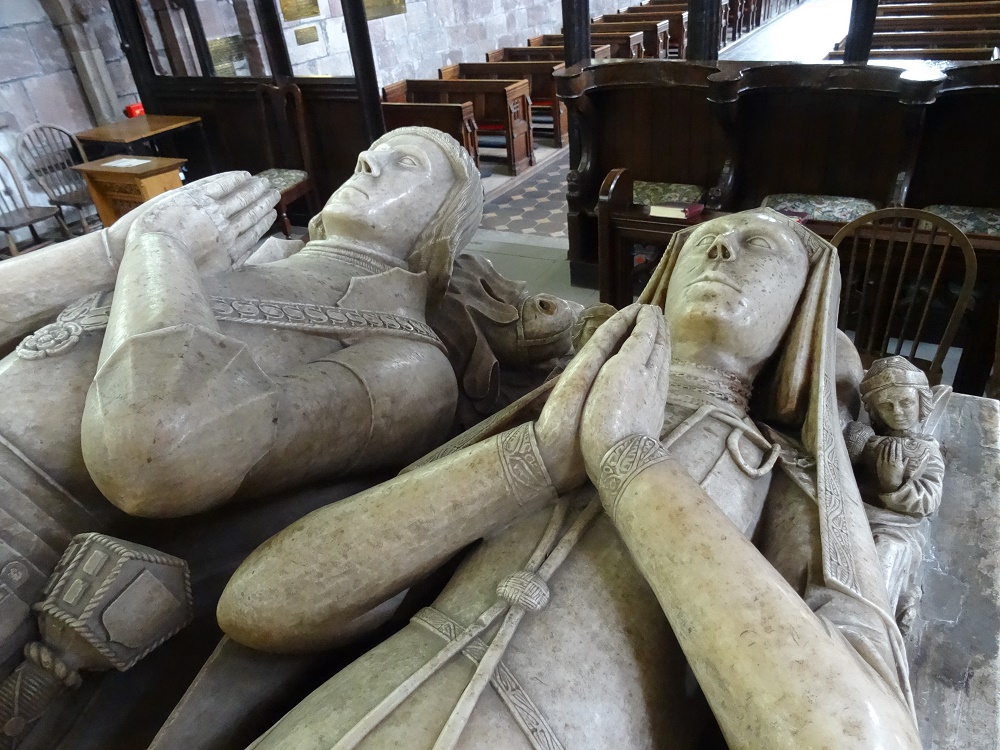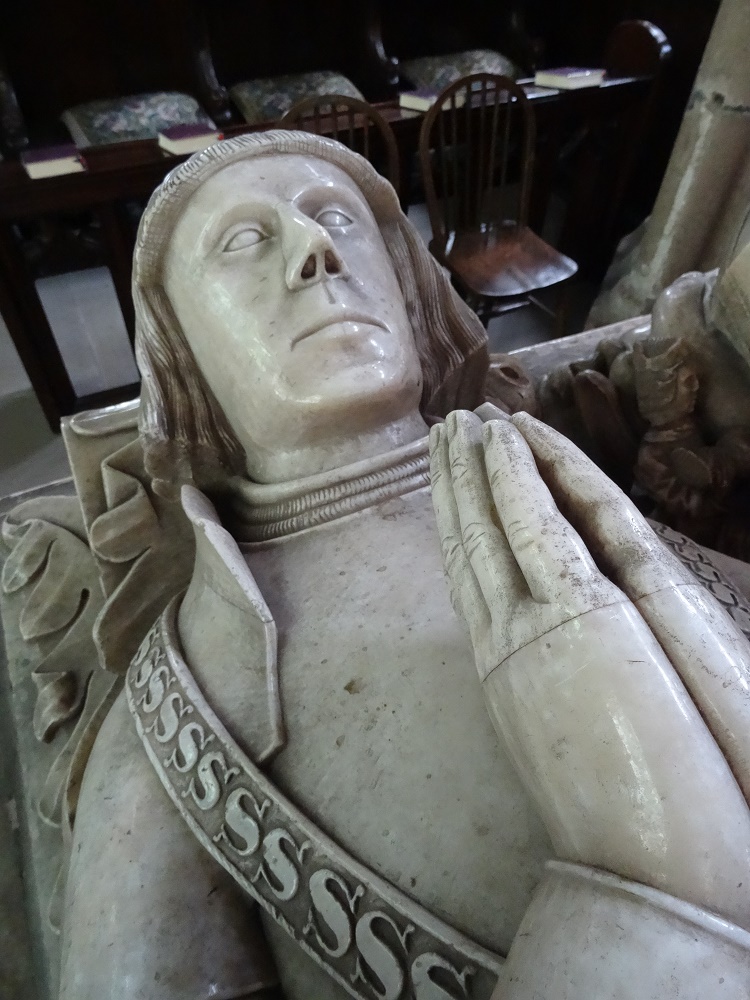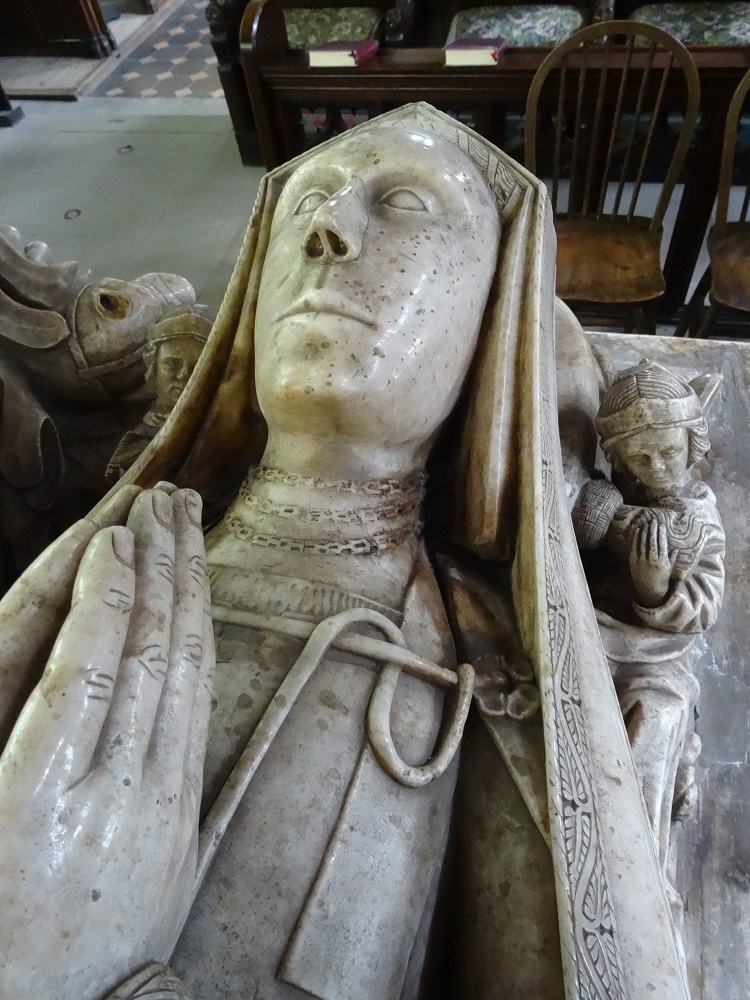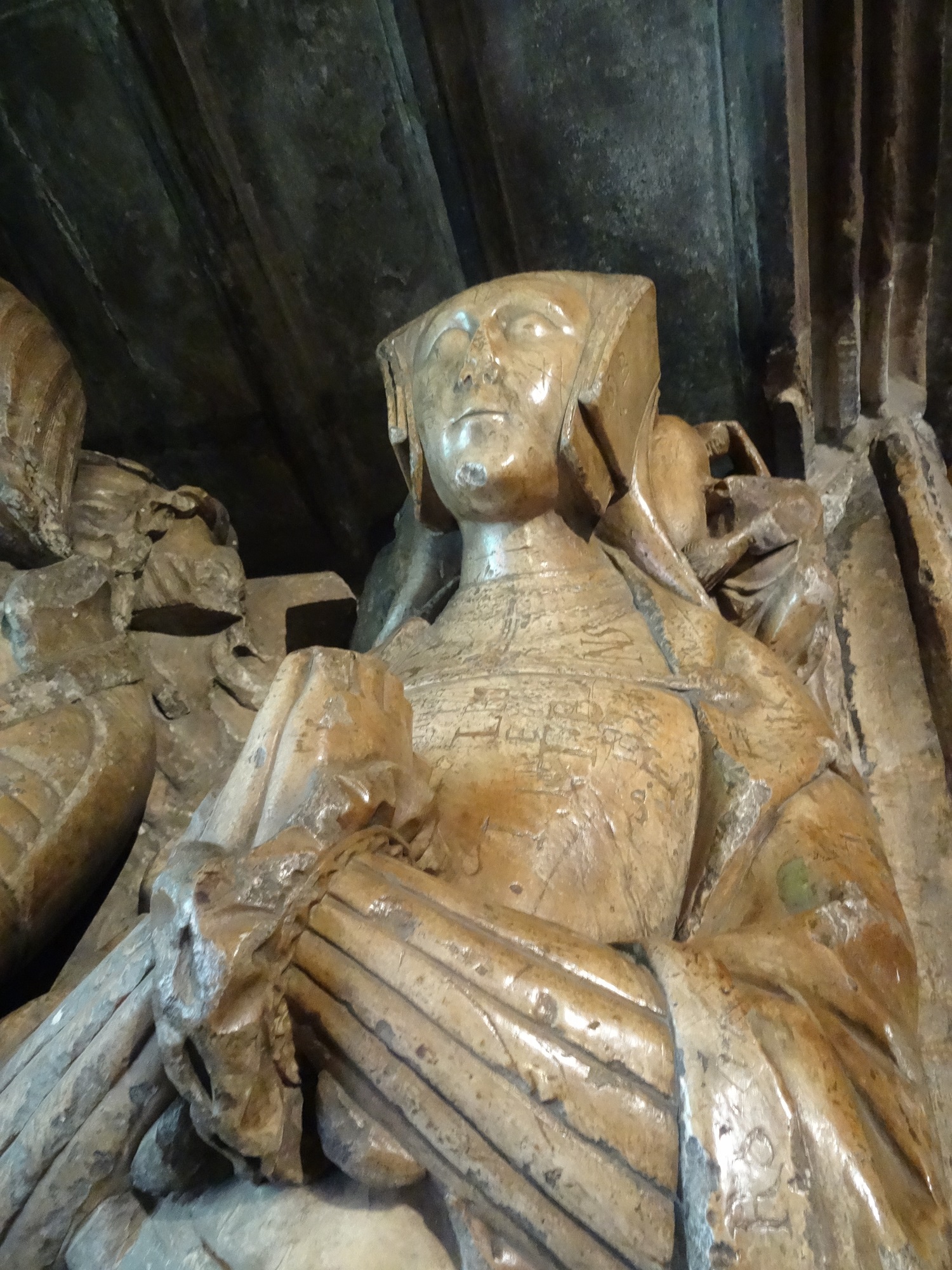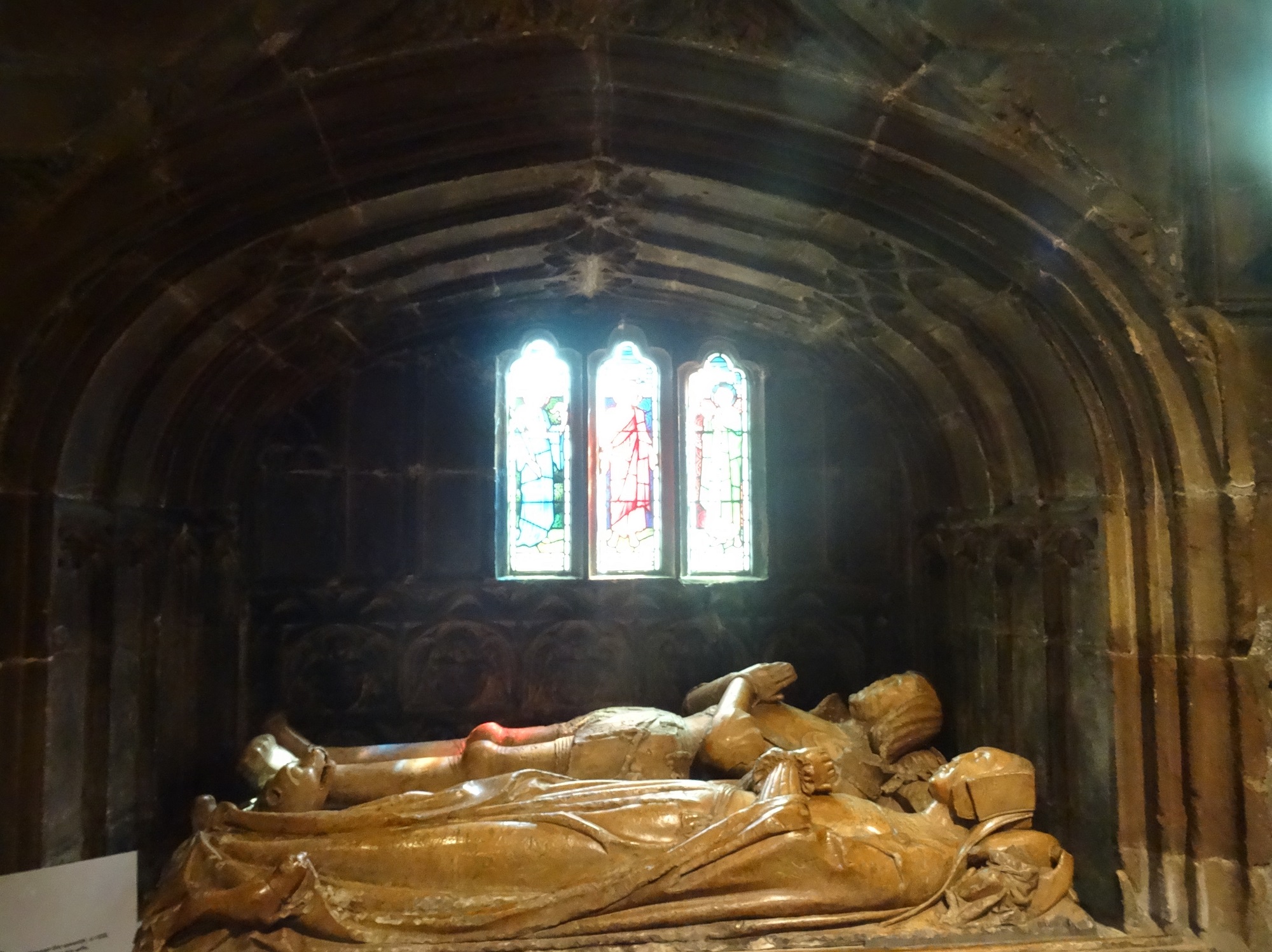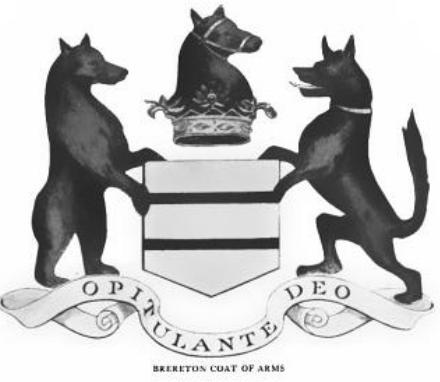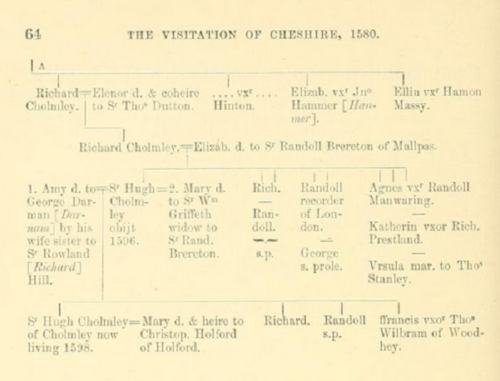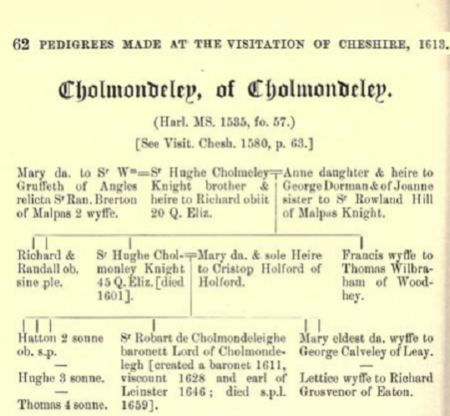Sir Randle Brereton and Eleanor Dutton
Sir Randle Brereton was of Ipstones, Staffordshire, England, as well as Shocklach and Malpas, Cheshire, England, the son of Randle Brereton and Emma Carrington.
Sir Randle married Eleanor Dutton. Boyer wrote, "E. W. Ives pointed out that notwithstanding this marriage the Duttons of Hatton were the greatest enemies of the Brereton family in Cheshire." Eleanor was of Hatton, Cheshire, England, the daughter of Peter Dutton and Elizabeth Fouleshurst.
Sir Randle was the Chamberlain of Chester (according to Boyer, from 21 Henry VII (1505-1506) to 23 Henry VIII (1531-1532), though he also states that he died in 1530). He was a knight of the body to Henry VII. He was made knight banneret by Henry VIII as reward for his conduct at Thérouanne and Tournai, France (this would be referring to service at the Battle of the Spurs in 1513). According to Merriam-Webster, a knight banneret was "a knight of an ancient English order of knighthood that was commonly conferred as a reward for valor on the field of battle and that entitled the holder to bear a banner rather than the pennon of a knight bachelor."
Sir Randle's will was made 3 June 1530 and proved 30 August 1530. Sir Randle died 3 or 8 June 1530. Eleanor survived Sir Randle. Both were buried at St. Oswald's church, Malpas, Cheshire, England. They had had the tomb made on Michaelmas (September 29) 1522, years before Sir Randle's death.
Sir Randall and Elizabeth’s children are:
- Randle Brereton, knight, married 1) Eleanor Egerton (dau. of Philip Egerton of Egerton and Oulton, Cheshire, England) and 2) Isabel Butler (dau. of Thomas Butler of Bewsey, Cheshire, England).
- Sir Richard Brereton, married Jane Massey (dau. of Sir Geoffrey Massey of Tatton, Cheshire, England), will dated 13 Apr 1553 and probated 2 Jul 1558.
- John Brereton, rector of Malpas (presented by his father to the rectory of a moiety of Malpas, 1499; said to have been rector for both moieties at one time), rector of Christleton, Cheshire, England in 1513-36, rector of Bebington, Cheshire, England in 1511 to after 1528, rector of Astbury, Cheshire, England in 1534-42, and said by Boyer to have been rector of St. Mary's in Chester, Cheshire, England, dean of the college of Astley, Warwickshire England in 1535, Canon of St. Paul's Cathedral, London, Middlesex, England in 1530-42 (collated (appointed to a benefice) as a prebendary of the Prebend of Horton 5 Aug 1530), died in 1542.
- Thomas Brereton, rector of the high moiety of Malpas, Cheshire, England, died in 1511.
- Peter Brereton, parson of Heswall, Cheshire, England 1533 and 1535, prebendary of Creswall, Derbyshire, England in 1535, vicar of Oswestry, Shropshire, England in 1537, king's chaplain.
- Sir Roger Brereton, married Katherine Brereton (dau. of Sir William Brereton of Brereton, Cheshire, England, m. 1) Edward Fulleshurst of Crewe, Cheshire, England).
- William Brereton, knight, married Elizabeth Somerset (dau. of Charles Somerset, Earl of Worcester, m. 1) Sir John Savage, bur. St. Michael's and All Angels Church, Macclesfield, Cheshire, England), Chamberlain of Chester, Groom of the Privy Chamber to Henry VIII. He was one of five men accused of adultery with Queen Anne Boleyn. Many historians believe that he was innocent of the charges and that an affair between William and the queen was not likely (the facts do not match the allegations). There is a possibility that Thomas Cromwell, the chief minister, had reasons to want him dead, as well as the queen. All five men were condemned and sentenced hung, then "cut down while still alive, disembowelled, castrated and finally to have their limbs quartered." The king, however, commuted to the sentence to a quicker and less painful death by beheading. William was executed 17 May 1536 at Tower Hill, London, Middlesex, England, along with the four other accused men and two days before Anne Boleyn's execution. He and three of the other men were buried in the churchyard outside the Chapel of St. Peter ad Vincula, Tower of London, London, Middlesex, England.
- Robert Brereton, living in 1566.
- Sir Urian Brereton, was of Handforth, Cheshire, England, married 1) Margaret Honford (William Honford of Handforth, Cheshire, England) dau. of and 2) Alice Trafford (dau. of Sir Edmund Trafford), died 19 Mar 1576/7, buried 16 Jun 1578 in Cheadle, Cheshire (now in Greater Manchester), England, inquisition post mortem taken at Knutsford, Cheshire, England 28 Mar 1580, a Groom of the Privy Chamber to Henry VIII, Ranger of Delamere Forest in 1526, Escheater of Cheshire in 1526, granted the office of Attorney of the King for life in Chester and Flint 8 Jul 1538, grant for life in survivorship of the office of Sheriff of Flintshire, Wales 1 Aug 1538, appointed for life with Randle Cholmondeley in survivorship of the office of Attorney of the Earl of Chester (later Edward VI) in Chester and Flint, accompanied the Earl of Hertford on an expedition to demand the infant Mary Queen of Scots (who had been promised to Prince Edward in marriage), present at the burning of Leith, Scotland (where he was knighted), the office of Escheater of Flintshire conferred for life in survivorship with relative Richard Brereton 7 Jul 1550.
- Anne Brereton, married 1) John Harcourt (of Ranton, Staffordshire, England) and 2) John Pershall (of Horseley, Staffordshire, England).
- Elizabeth Brereton, married 1) Richard Cholmondeley (also called Cholmley, son of Richard Cholmondley and prob. Alianor Dutton, of Cholmondeley in the parish of Malpas, Cheshire, England, may have m. 1) Elizabeth Corbet, d. 1518) and 2) Sir Randall Mainwaring (b. abt. 1495 to Sir John Mainwaring and Katherine Honford, of Over Peover, Cheshire, England, m. 2) Elizabeth Leycester in 1552, d, 6 Sep 1557.
- Jane Brereton, married Sir Thomas Hanmer (of Hanmer, Flintshire, Wales).
- Eleanor Brereton, married Sir William Brereton (of Brereton, Cheshire, England).
Sources:
- Glover, Robert, The visitation of Cheshire in the year 1580, London: The Harleian Society, 1882, pgs. 43-44, 64.
- Ormerod, George, The History of the County Palatine and City of Chester, Vol. 2, London: Nichols, Son, and Bentley, 1819, p. 356.
- Armytage, George J., and Rylands, John Paul (ed.), Pedigrees Made at the Visitation of Cheshire, 1613, London: Record Society for the Publication of Original Documents relating to Lancashire and Cheshire, 1909, p. 62.
- Collins, Arthur and Brydges, Sir Egerton, Collins's Peerage of England, London: Otridge and Son, 1812, pgs. 23-6. This book can be found online at https://archive.org/stream/collinsspeerageo04coll#page/22/mode/2up
- Tomb of Sir Randle and Eleanor (Dutton) Brereton, St. Oswald's Church, Malpas, Cheshire, England.
- Tomb of Elizabeth (Somerset) (Savage) Brereton (and her first husband, Sir John Savage), St. Michael's and All Angels Church, Macclesfield, Cheshire, England.
- Shaw, William Arthur, The Knights of England, Vol. 2, London: Sherratt and Hughes, 1906, p. 36. This book can be found online at Archive.org.
- Bell, Doyne C., Notices of the Historic Persons Buried in the Chapel of St. Peter ad Vincula in the Tower of London, London: John Murray, 1877, p. 42. This book can be found online at Google Books.
- Jones, Douglas, The Church in Chester 1300-1540, Manchester: The Chetham Society, 1957, pgs. 166, 176. This book can be found online at Google Books.
- Dugdale, Sir William, The History of St. Paul's Cathedral, in London, from its Foundation, London: Lackington, Hughes, Harding, Mavor, and Jones, 1818, p. 255. This book can be found online at Google Books.
- Earwaker, J.P., "The Four Randle Holmes, of Chester," Journal of the Chester Archaeological and Historic Society, Vol. 4, Chester and North Wales Architectural, Archaeological, and Historic Society, 1892, p. 127.
- Amyot, Thomas, "Transcript of an original Manuscript, containing a Memorial from George Constantyne to Thomas Lord Cromwell," (read 21 and 28 Jan 1830), Archaelogica, or Miscellaneous Tracts Relating to Antiquity, Vol. 23, London: J.B. Nichols and Son, 1851, p. 65. This book can be found online at Archive.org.
- Wriotheseley, Charles (died 1562) and Hamilton, William Douglas (ed.), A Chronicle of England during the Reigns of the Tudors, from A.D. 1485 to 1559, Vol. 1, Westminster: J.B. Nichols and Sons, 1875, pgs. 36-42. This book can be found online at Archive.org.
- Croston, James, Historic Sites of Lancashire and Cheshire : A Wayfarer's Notes in the Palatine Counties, Historical, Legendary, Genealogical and Descriptive, London: J. Heywood, 1883, pgs. 196-8. This book can be found online at Archive.org.
Records related to Sir Randle and Eleanor (Dutton) Brereton but not copied below due to copyright considerations:
- Boyer, Carl, Medieval English Ancestors of Robert Abell, Santa Clarita, CA: C. Boyer, 2001.
- Will of Sir Randall Breerton, Chamberlain of Chester of Malpasse, Cheshire, The National Archives of the UK (TNA): PROB 11/23/338.
- Will of Sir Richard Brereton or Brerton of Tatton, Cheshire, The National Archives of the UK (TNA): PROB 11/40/343.
- Ives, E. W., "The Fall of Anne Boleyn Reconsidered," The English Historical Review, Vol. 107, Issue 424 (July 1992), pgs. 651–664. PDF available at https://academic.oup.com/ehr/article-lookup/doi/10.1093/ehr/CVII.CCCCXXIV.651, retrieved 20 Aug 2017.
- Ives, Eric W., William Brereton and the Pork Barrel: Travails of Political Ascendancy, Lecture delivered to the Worldwide Brereton Family Reunion, Holly Lodge, Holmes Chapel, Cheshire, 30 July 2001. Transcript available at http://brereton.org/professor_eric_ives.htm, retrieved 20 Aug 2017.
- Ives, E. W., Letters and Accounts of William Brereton of Malpas, Old Woking, Surrey: Unwin Brothers Limited (printed for The Record Society of Lancashire and Cheshire, vol. 116), 1976.
- Ives, Eric, The Life and Death of Anne Boleyn, Oxford: Blackwell Publishing, 2004.
- Ridgway, Claire, "William Brereton," Parts 1 and 2, The Anne Boleyn Files, https://www.theanneboleynfiles.com/sir-william-brereton/3343/ and https://www.theanneboleynfiles.com/sir-william-brereton-part-2/, retrieved 20 Aug 2017.
- "Handforth Hall," Historic England, List entry Number: 1222483, https://historicengland.org.uk/listing/the-list/list-entry/1222483 (retrieved 21 Aug 2017).
Images
Tomb of Sir Randle and Eleanor (Dutton) Brereton, St. Oswald's Church, Malpas, Cheshire, England (photo credit: Peter Cox, findagrave.com):
Translation by Peter Cox of the inscription in Latin around the edge of the tomb:
Here lie Randal Brereton Knight Banneret and Chamberlain of the County of Chester and the Lady Eleanor his wife, which said Randal and Eleanor, while yet living, had this tomb made, to wit at the feast of St Michael the Archangel AD 1522 on whose souls may God have mercy, Amen.
Additional photos of this tomb can be found at Craig Thornber's Malpas page: http://www.thornber.net/cheshire/htmlfiles/malpas.html
For an overhead view, see C B Newham FSA on Twitter: https://twitter.com/cbnewham/status/769917659643338753
Tomb of Elizabeth (Somerset) (Savage) Brereton (and her first husband, Sir John Savage), St. Michael's and All Angels Church, Macclesfield, Cheshire, England (photo credit: Peter Cox, findagrave.com):
Handforth Hall (Handforth, Cheshire, England), built for Sir Urian Brereton in 1562 (Photo credit: By Mike in Macc (Own work) [CC BY-SA 3.0 (http://creativecommons.org/licenses/by-sa/3.0)], via Wikimedia Commons):
An inscription on a lintel reads:
"THIS HAULLE WAS BUYLDED IN THE YEARE OF OUR LORD GOD MCCCCCLXll BY URYAN BRERETON KNIGHT WHOM MARYED MARGARET DAUGHTER AND HEYRE OF WYLLYAM HANDFORTH OF HANDFORTHE ESQUYER AND HAD ISSUE VI SONNES AND II DAUGHTERS".
See "Handforth Hall," Historic England, List entry Number: 1222483, https://historicengland.org.uk/listing/the-list/list-entry/1222483 (retrieved 21 Aug 2017) for more information on this property.
Brereton Arms:
Chronicles and Other Accounts
DEANE. But what can ye tell of Brerton ? GEORGE. By my troeth, yf any of them was innocent, it was he. For other he was innocente or els he dyed worst of them all. DEANE. How so ? GEORGE. Apon thursdaye afore Maye daye in the mornynge I spake with hym abowt nyne of the clocke, And he tolde me that there was no waye but one with any matter. For I did aske hym & was bold apon hym because we were borne within foure myles together, And also we wente to grammar scole together. And the same daye afore ij of the clock was he in the towre as ferre as the best. What was layed against hym I know not nor never hearde. But at his deeth these were his wordes : I haue deserved to dye if it were a thousande deethes, But the cause wherfore I dye judge not: But yf ye judge, judge the best. This he spake iij or foure tymes. If he were gyltie, I saye therfore that he dyed worst of them all.
Source: Amyot, Thomas, "Transcript of an original Manuscript, containing a Memorial from George Constantyne to Thomas Lord Cromwell," (read 21 and 28 Jan 1830), Archaelogica, or Miscellaneous Tracts Relating to Antiquity, Vol. 23, London: J.B. Nichols and Son, 1851, p. 65. This book can be found online at Archive.org.
Item, the 12th daie of Maie, 1536, being Fridaie, their were arraygned at Westminster Sir Frances Weston, knight, Henrie Norris, esquier, Brerton, and Markes, being all fower of the Kinges Privie Chamber, and their condempned of high treason against the Kinge for using fornication with Queene Anne, wife to the Kinge, and also for conspiracie of the Kinges death, and their judged to be hanged, drawen, and quartered, their members cutt of and brent before theim, their heades cutt of and quartered ; my Lord Chauncelor being the highest Commissioner he geving their judgment, with other lordes of the Kinges Counsell being presente at the same tyme.
And the morrowe after, being Satterdaie, and the thirtenth daie of Maie, Maister Fittes-Williams, Treasorer of the Kinges howse, and Mr. Controoler, deposed and brooke upp the Queenes househoulde at Greenewich, and so discharged all her servantes of their offices clearlye.
Item, on Munday, c the 15th of May, 1536, there was arreigned within the Tower of London Queene Anne, for treason againste the Kinges owne person, and there was a great scaffold made in the Kinges Hall within the Tower of London, and there were made benches and seates for the lordes, my Lord of Northfolke sittinge under the clothe of estate, representinge there the Kinges person as Highe Steward of Englande and uncle to the Queene, he holdinge a longe white staffe in his hande, and the Earle of Surrey, his sonne and heire, sittinge at his feete before him holdinge the golden staffe for the Earle Marshall of Englande, which sayde office the saide duke had in his handes ; the Lord Awdley, Chauncellour of England, sittinge on his right hande, and the Duke of Suffolke on his left hande, with other marqueses, earles, and lordes, everie one after their degrees.
And first the Kinges commission was redd, and then the Constable of the Tower and the Lieutenant brought forthe the Queene the barre, where was made a chaire for her to sitt downe in, and Tower of then her indictment was redd afore her, whereunto she made so wise and discreet aunsweres to all thinges layde against her, excusinge herselfe with her wordes so clearlie, as thoughe she had never bene faultie to the same, and at length putt her to the triall of the Peeres of the Realme, and then were 26 of the greatest peeres there present
chosen to passe on her, the Duke of Suffolke beinge highest, and, after thei had communed together, the yongest lorde of the saide inquest was called first to give verdict, who sayde guiltie, and so everie lorde and earle after their degrees sayde guiltie to the last and so condemned her. And then the Duke of Northfolke gave this sentence on her, sayinge : Because thou haste offended our Sovereigne the Kinges grace, in committinge treason against his person, and here attaynted of the same, the lawe of the realme is this, that thou haste deserved death, and thy judgment is this : That thow shalt be brent here within the Tower of London on the Greene, els to have thy head smitten of as the Kinges pleasure shal be further knowne of the same; and so she was brought to warde agayne, and two ladies wayted on her, which came in with her at the first, and wayted still on her, whose names were the Ladie Kingstone and the Ladie Boleyn, her aunte.
After this, immediatlie, the Lord of Rocheforde, her brother, was arreigned for treason, which was for knowinge the Queene, his sister, carnallie, moste detestable against the lawe of God and nature allso, and treason to his Prince, and allso for conspiracie of the Kinges death: Whereunto he made aunswere so prudentlie and wiselie to all articles layde against him, thatmarveil it was to heare, and never would confesse anye thinge, but made himselfe as cleare as though he had never offended. Howbeit he was there condemned by 26 lordes and barons of treason, and then my Lord of Northfolke gave him this judgment: That he should goe agayne to prison in the Tower from whence he came, and to be drawne from the saide Towre of London thorowe the Cittie of London to the place of execution called Tyburne, and there to be hanged, beinge alyve cutt downe, and then his members cutt of and his bowells taken owt of his bodie and brent before him, and then his head cutt of and his bodie to be divided in 4 or peeces, and his head and bodie to be sett at suche places as the King should assigne ; and after this the court brake up for that tyme. The Major of London with certeyne Aldermen were present at this arreignment of the Queene and her brother, with the wardeins and 4 persons more of 12 of the principall craftes of London.
Allso the 17th day of May, beinge Weddensday, the Lord of Rochforde, Mr. Norys, Mr. Bruton, Sir Francis Weston, and Markys, were all beheaded at the Tower-hill ; and the Lord of Rocheforde, brother to Queene Anne, sayde these wordes followinge on the scaffold e to the people with a lowde voyce : Maisters all, I am come hither not to preach and make a sermon, but to dye, as the lawe hath fownde me, and to the lawe I submitt me, desiringe you all, and speciallie you my maisters of the Courte, that you will trust on God speciallie, and not on the vanities of the worlde, for if I had so done, I thincke I had bene alyve as yee be now; allso I desire you to helpe to the settinge forthe of the true worde of God; and whereas I am sclaundered by it, I have bene diligent to reade it and set it furth trulye; but if I had bene as diligent to observe it, and done and lyved thereafter, as I was to read it and sett it forthe, I had not come hereto, wherefore I beseche you all to be workers and lyve thereafter, and not to reade it and lyve not there after. As for myne offences, it can not prevayle you to heare them that I dye here for, but I beseche God that I may be an example to you all, and that all you may be wayre by me, and hartelye I require you all to pray for me, and to forgive me if I have offended you, and I forgive you all, and God save the Kinge. Their bodies with their heades were buried within the Tower of London; the Lord of Rochfordes bodie and head within the chappell of the Tower, Mr. Weston and Norys in the church yeard of the same in one grave, Mr. Bruton and Markes in another grave in the same churche yerde within the Tower of London.
And the same day, in the after-noone, at a solemne court kept at Lambeth by the Lord Archbishoppe of Canterburie and the doctors of the lawe, the King was divorsed from his wife Queene Anne, and there at the same cowrte was a privie contract approved that she had made to the Earle of Northumberlande afore the Kings tyme ; and so she was discharged, and was never lawfull Queene of England,
and there it was approved the same.
The Fridaye followinge, beinge the 19th day of May. 1536, and the 28 th yeare of King Henry the VIIIth, at eight of the clocke the Tower with in the morninge, Anne Bulleyn, Queene, was brought to execution on the greene within the Tower of London, by the great White Tower; the Lord Chauncelloure of England, the Duke of Richmond, Duke of Suffolke, with the moste of the Kings Councell, as erles, lordes, and nobles of this realme, beinge present at the same; allso the Major of London, with the Alldermen and Sheriffs, and certayne of the best craftes of London, beinge there present allso. On a scaffolde made there for the sayde execution the sayde Queen Ann sayde thus: Maisters, I here humblye submitt me to the lawe as the lawe hath judged me, and as for myne offences, I here accuse no man, God knoweth them; I remitt them to God, beseechinge him to have mercye on my sowle, and I beseche Jesu save my sovereigne and maister the Kinge, the moste godlye, noble, and gentle Prince that is, and longe to reigne over yow; which wordes were spoken with a goodlye smilinge countenance; and this done, she kneeled downe on her knees and sayde: To Jesu Christe I commend my sowle; and suddenlye the hangman smote of her heade at a stroke with a sworde; her bodye with the head was buried in the Chappell within the Tower of London, in the queere there, the same daye at afternoone, when she had reygned as Queene three yeares, lackinge 14 dayes, from her coronation to her death.
Source: Wriotheseley, Charles (died 1562) and Hamilton, William Douglas (ed.), A Chronicle of England during the Reigns of the Tudors, from A.D. 1485 to 1559, Vol. 1, Westminster: J.B. Nichols and Sons, 1875, pgs. 36-42. This book can be found online at Archive.org.
Knighthood Records
[?1513, Aug. 16.] Possibly at the Battle of Spurs in France.
Knights Bannerets.
...
Randolf Brereton, marshal of the Rearward.
...
Source: Shaw, William Arthur, The Knights of England, Vol. 2, London: Sherratt and Hughes, 1906, p. 36. This book can be found online at Archive.org.
Histories, Archaelogical Reports, and Historical Journals
Mr. Peter Brereton; occurs as rector of Heswall, 1533 and 1535 (Ormerod, vol. II, p. 515; Valor, vol. V, p. 213); in 1535, as prebendary of Creswall, in the collegiate church of the Blessed Mary of Stafford (ibid., vol. III, p. 119), and, in 1537, as vicar of Oswestry (Thomas, op. cit. p. 655). Occurs as king's chaplain. (Letters and Papersof Henry VIII, Addenda, vol. I, pt. II, p. 478.) About the beginning of 1539 (ibid.), he complained to the Court of Requests that the sum of £3 per annum was being wrongfully withheld from him by the dean and chapter. But the dean had the support of the bishop, who, in his turn, had the support of Cromwell, so that it is most unlikely that the Court's order to the dean and chapter (ibid.) to do right to Brereton was of much benefit to him. (Cheshire Sheaf, Third Series, vol. XVIII, p. 27.) Brereton may have been the fifth son of Sir Randle Brereton of Shocklach and Malpas, and so a brother of that John Brereton who was rector of St. Mary's on the Hill, 1534-42. (Ormerod, vol. II, p. 687.)
...
Mr. John Brereton, LL.D., presented by the abbot and convent, 11 May, 1534; dead before Nov., 1542. The third son of Sir Randle Brereton of Shocklach (Ormerod, vol. II, p. 687), who presented him to the rectory of a moiety of Malpas, 1499 (Ormerod, vol. II, p. 607). Ormerod says he appears to have held it only for a few months, but he was rector of one of the moieties in 1535. (Valor, vol. V, p. 212.) He is also said to have held both moieties at one time. (Ormerod, loc. cit.) 1513-36, rector of Christleton. (Ibid., p. 782.) 1511-ante 1528, rector of Bebington. (Ibid., p. 439.) 1534-42, rector of Astbury. (Ibid., vol. III, p. 26.) 1535, dean of the college of Astley, Warwickshire. (Valor, vol. III, p. 61.) Canon of St. Paul's, 1530-42. (Hennessey, p. 32.)
Source: Jones, Douglas, The Church in Chester 1300-1540, Manchester: The Chetham Society, 1957, pgs. 166, 176. This book can be found online at Google Books.
Prebend of Horton.
The corps of this prebend lies in the parish of St. Leonard Shoreditch...
Prebendaries
...
John Brereton was collated Aug. 5th, 1530.
Source: Dugdale, Sir William, The History of St. Paul's Cathedral, in London, from its Foundation, London: Lackington, Hughes, Harding, Mavor, and Jones, 1818, p. 255. This book can be found online at Google Books.
The site of this house, which was then two gardens, having Bridge Street [in Chester, Cheshire, England] on the east side, and Castle Lane on the south, was sold on the 1st April, 15 Henry VIII. [1524], to Randle Brereton, of Chester, and as recorded in Harl. MS. 2022, f. 182, &c., "on these garden places Randle Brereton, Esq., late Vice Chamberlain of Chester, built severall houses now inhabited by Will. Ball, Ran. Holme, Thomas Wright and Margaret Hooker." This property was subsequently sold on the 4th November, 22 Elizabeth [1580], by Richard Brereton, of Eccleston, Esq., to Robert Ireland, of Halewood, co. Lancaster, gentleman.
Source: Earwaker, J.P., "The Four Randle Holmes, of Chester," Journal of the Chester Archaeological and Historic Society, Vol. 4, Chester and North Wales Architectural, Archaeological, and Historic Society, 1892, p. 127.
Many interments took place in the churchyard outside; for instance, Norris, Brereton, Weston, and Smeaton, were buried there in 1536.
Source: Bell, Doyne C., Notices of the Historic Persons Buried in the Chapel of St. Peter ad Vincula in the Tower of London, London: John Murray, 1877, p. 42. This book can be found online at Google Books.
Sir William Brereton, who came to so untimely an end in 1536, had a younger brother, Urian Brereton, who in his earlier life was also one of the Grooms of the Privy Chamber. In 1526 he was appointed Ranger of Delamere Forest, and the same year Escheater of Cheshire, the latter an office he also held in the successive reigns of Edward VI., Mary, and Elizabeth, until his death in 1577. On the voluntary seclusion of Sir John Stanley, Urian Brereton married his divorced wife, Margaret, the daughter of William Honford, and thus became the founder of the line of Brereton of Handforth.
The vindictive feeling which Henry manifested towards Sir William Brereton was not extended to the person of his younger brother, for the King, as if to mark the appeasement of his wrath, not only retained him in his position as Groom of the Privy Chamber, but also conferred other offices of distinction upon him. On the 8th July, 1538, he had a grant for life of the office of Attorney of the King in the counties of Chester and Flint ; and on the 1st of August following he had a grant for life in survivorship of the office of Sheriff of the county of Flint on the surrender of the same by his kinsman, John Brereton, on whom it had been bestowed four months previously, and on the 16th of June, 1543, he and Randle Cholmondeley had conferred upon them the appointment for life, in survivorship, of the office of Attorney of the Earl of Chester (the young Prince Edward) in the counties of Chester and Flint. In 1544 he accompanied the Earl of Hertford in the expedition to Scotland to demand the infant Queen Mary, who had been promised in marriage to the King's son, Edward Earl of Chester, and he was present at the burning of Leith, where, in acknowledgment of his valorous deeds, he received the honour of knighthood.
Shortly after the expedition to Scotland Sir Urian Brereton had the misfortune to lose his wife, Dame Margaret, who died at Handforth Hall, though the exact date of her decease has not been ascertained, the registers of Cheadle, where doubtless she was buried, not commencing until 1558. Her manors and lands descended to the son by her first husband, John Stanley, who on the 24th May, 1 Edward VI. (1547) entered into a covenant with Sir Urian Brereton under which the estates were settled between them.
On the 7th of July, 1550, Sir Urian and his relative, Richard Brereton, Esq., had conferred upon them for life, in survivorship, the office of Escheater of the county of Flint, and shortly after he commenced the rebuilding of the Hall of Handforth, completing it in 1562, as the inscription over the door, which has been already given, testifies. He also about the same time erected the handsome carved oak screen in the Brereton chantry at Cheadle church, placing upon it his initials, V. B., and his punning rebus, a briar and a tun.
After the death of Dame Margaret Sir Urian again entered the marriage state, his second wife being Alice, the third daughter of Sir Edmund Trafford, of Trafiford, Esq., and the widow of Sir William Leyland, of Morleys Hall, in Astley. His death occurred at Handforth Hall on the 19th of March, 1577, and twelve days later his remains were interred at Cheadle. By his first wife he had, as the inscription over the porch at Handforth records, six sons and two daughters, and by his second wife, who survived him little more than a year, one son and four daughters. His Inquisition was taken at Knutsford on the 28th March, 1580...
Source: Croston, James, Historic Sites of Lancashire and Cheshire : A Wayfarer's Notes in the Palatine Counties, Historical, Legendary, Genealogical and Descriptive, London: J. Heywood, 1883, pgs. 196-8. This book can be found online at Archive.org.
Visitations, Pedigrees, and Peerages
Source: Glover, Robert, The visitation of Cheshire in the year 1580, London: The Harleian Society, 1882, pgs. 43-44, 64.
Source: Armytage, George J., and Rylands, John Paul (ed.), Pedigrees Made at the Visitation of Cheshire, 1613, London: Record Society for the Publication of Original Documents relating to Lancashire and Cheshire, 1909, p. 62.
Source: Ormerod, George, The History of the County Palatine and City of Chester, Vol. 2, London: Nichols, Son, and Bentley, 1819, p. 356.
Richard de Cholmondley, who married Eleanor, fifth daughter of Sir Thomas Dutton, of Dutton, and sister and coheir to John, her brother, who died before he was of full age.
...
He left issue a son,
Richard Cholmondeley, Esq. one of the Justices ubefore whom fines were levied, from 1/ Henry VIL to 24 Henry VIII, and who, in 30 Henry VIII. departed this life,x seised (as the inquisition shews, taken March 20, the same year), of the manors of Cholmondlcy, Church Minsule, and Aston ; and of divers other manors and lands in Gildon, Sutton, Broughton, Pulton-Lancelyn, Whitley, Hawarden, Copenhurst, Laerton, Chorley, Badcley, Bikerton, Malpas, Hampton, Ebnall, Tushingham, Bradeley, and Kinderton. He repaired the chancel of Cbolmondley in the beginning of the reign of Henry VIII. and on the skreen of it his arms are cut, and this inscription ; " Orate pro bono " statu Richardi Cholmundley et Elizabeth Uxoris ejus, sacelli " factoris, Anno Domini Millesimo quingentestmo quarto decimo." He married, first, Elizabeth, daughter to Sir Roger Corbet, of Morton Corbet, in com. Salop, Knt. by whom he had issue an only daughter, Maud, wedded to Sir Peter Newton, Knt. But by his second wife Elizabeth, daughter to Sir Randle Brereton of Malpas, chamberlain of Chester (who survived him, and was afterwards married to Sir Randle Mainwaring, of Over Pever, Knt.) he had several children 3 whereof these daughters were married, viz. Catherine, to Richard Priestland, of Priestland and Wardhill, in Cheshire, Esq. ; Agnes, to Randle Mainwaring, of Caringtun, Esq. 3 and Ursula, to Thomas Stanley, of Wever, Esq, Hugh Choldmondley was his eldest son and heir; and Randle Cholmondley, a younger son...
u Fines in Offic. Prothon. Cestr. de iisd. Ann.
x Esc. 30 Hen. VIII.
Source: Collins, Arthur and Brydges, Sir Egerton, Collins's Peerage of England, London: Otridge and Son, 1812, pgs. 23-6.
This book can be found online at https://archive.org/stream/collinsspeerageo04coll#page/22/mode/2up
